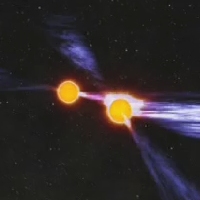XMM-Newton unveils the double pulsar in X-rays
23 June 2008
XMM-Newton observations of the unique double pulsar system PSR J0737-3039 have confirmed pulsed X-ray emission from one component and, for the first time, provided strong evidence for X-ray emission from the second pulsar. The XMM-Newton data show that this unusual system displays complex X-ray behaviour.This is reported by Alberto Pellizzoni and colleagues in the 20 May 2008 issue of The Astrophysical Journal.
 |
|
Artist's impression of the double pulsar system PSR J0737-3039. (Click on the image to see an animation of the system.) Credit: John Rowe Animations |
Pulsars are rapidly spinning neutron stars typically observed as isolated, radio-emitting objects. The coupling of two pulsars orbiting in a binary system is an extremely rare phenomenon. The system contains a slowly rotating neutron star (pulsar B) orbiting a faster and more energetic companion (pulsar A). Radio observations have revealed a rich variety of observational phenomena, including eclipses and modulations of the radio flux arising from the geometry of the system and the interaction of the pulsars.
Due to the compactness of the orbit (the neutron stars are separated by only 3 light-seconds), this double pulsar is of immense interest as a probe for theories of strong field gravity. Future tests of general relativity using radio observations of J0737-3039 will supersede the best current solar system tests.
The double pulsar also represents a unique laboratory for studies in several other fields, ranging from the equation of state of super-dense matter to magneto-hydrodynamics. Observations of X-ray emission are a fundamental component of these studies, in particular for aspects concerning the physics of the interacting pulsars winds and magnetospheres in the close environment of the two neutron stars.
The results reported by Pellizzoni et al are based on a long observation (
This deep observation revealed a complex X-ray phenomenology that cannot be simply ascribed to pulsar A alone, although it is clear that the only significant power plant of the system is the energy release of this pulsar.
For the first time X-ray emission was detected from pulsar B. This is unexpected since the rotational energy loss of pulsar B is insufficient to produce the observed X-ray luminosity. In addition, the X-ray emission is unlikely to arise from residual internal heat of this 50 million year old pulsar. The detection of X-rays from pulsar B provides strong evidence for the mutual interaction of the two pulsars at high energies. The authors propose that the X-ray emission from pulsar B could be ultimately powered or heated by the wind of pulsar A heating the surface of pulsar B. This is consistent with the observation that the emission from pulsar B is only seen during orbital phases when the wind from pulsar A could intercept pulsar B.
The fundamental physical processes involved in these extreme interactions are a matter of debate among theoretical physicists. These results from XMM-Newton provide new insight into the phenomenology of this double pulsar and provide an opportunity to test several proposed models.
Web story author:
Alberto Pellizzoni
INAF-IASF/CNR, Milan, Italy
E-mail: alberto iasf-milano.inaf.it
iasf-milano.inaf.it
Related articles:
Pellizzoni, A. et al, "PSR J0737-3039: Interacting pulsars in X-rays", Ap. J., 679, pg 664-674, 2008, doi:10.1086/587053

